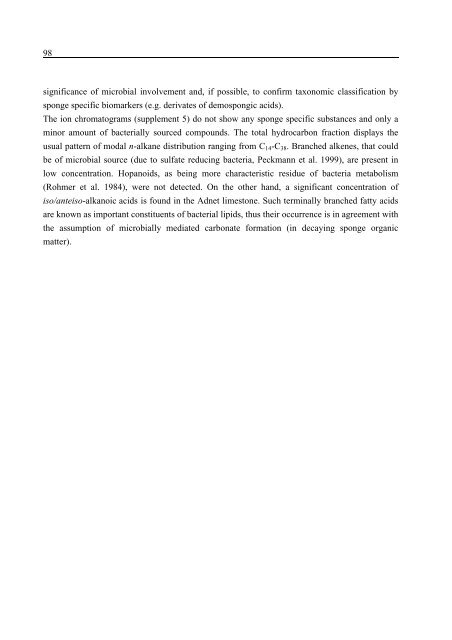Porifera-microbialites of the Lower Liassic (Northern Calcareous ...
Porifera-microbialites of the Lower Liassic (Northern Calcareous ...
Porifera-microbialites of the Lower Liassic (Northern Calcareous ...
Create successful ePaper yourself
Turn your PDF publications into a flip-book with our unique Google optimized e-Paper software.
98<br />
significance <strong>of</strong> microbial involvement and, if possible, to confirm taxonomic classification by<br />
sponge specific biomarkers (e.g. derivates <strong>of</strong> demospongic acids).<br />
The ion chromatograms (supplement 5) do not show any sponge specific substances and only a<br />
minor amount <strong>of</strong> bacterially sourced compounds. The total hydrocarbon fraction displays <strong>the</strong><br />
usual pattern <strong>of</strong> modal n-alkane distribution ranging from C14-C38. Branched alkenes, that could<br />
be <strong>of</strong> microbial source (due to sulfate reducing bacteria, Peckmann et al. 1999), are present in<br />
low concentration. Hopanoids, as being more characteristic residue <strong>of</strong> bacteria metabolism<br />
(Rohmer et al. 1984), were not detected. On <strong>the</strong> o<strong>the</strong>r hand, a significant concentration <strong>of</strong><br />
iso/anteiso-alkanoic acids is found in <strong>the</strong> Adnet limestone. Such terminally branched fatty acids<br />
are known as important constituents <strong>of</strong> bacterial lipids, thus <strong>the</strong>ir occurrence is in agreement with<br />
<strong>the</strong> assumption <strong>of</strong> microbially mediated carbonate formation (in decaying sponge organic<br />
matter).

















